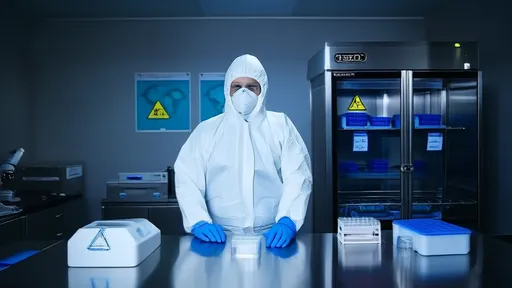The world of scent detection has long been dominated by the unparalleled olfactory abilities of canines. From sniffing out explosives to detecting diseases, dogs have proven time and again that their noses are among nature's most sophisticated chemical analyzers. However, recent advancements in electronic nose (e-nose) technology are challenging this biological supremacy by attempting to mechanically replicate the canine sense of smell. This emerging field promises to revolutionize industries ranging from healthcare to security, offering a consistent, tireless alternative to our four-legged friends.
At the heart of this technological pursuit lies a fundamental question: how can machines mimic a biological system that evolved over millions of years? The canine nose operates through approximately 300 million olfactory receptors, compared to a mere 6 million in humans. These receptors don't just detect odors—they analyze complex chemical signatures with incredible sensitivity and specificity. Electronic noses seek to emulate this through arrays of chemical sensors combined with pattern recognition systems, creating artificial olfaction that can learn and adapt much like a dog's brain does.
The development of e-nose technology capable of matching canine performance requires innovations at multiple levels. Sensor materials must become more sensitive and selective, capable of detecting odor molecules at parts-per-trillion concentrations. Equally important is the data processing backend, which must interpret complex sensor responses and distinguish meaningful patterns from noise—a computational challenge akin to teaching a machine to "understand" smells rather than just detect them. Recent breakthroughs in nanomaterials and machine learning are bringing these requirements within reach.
One particularly promising application lies in medical diagnostics. Dogs have demonstrated an uncanny ability to detect various cancers, diabetes, and even malaria through scent. Electronic noses could make this capability widely available without the logistical challenges of training and maintaining detection dogs. Prototype devices have already shown success in identifying lung cancer from breath samples and urinary tract infections from urine odor profiles—with accuracy rates approaching those of canine detection.
Security and safety represent another frontier for this technology. Airports and other high-security venues currently rely heavily on canine teams for explosives detection. While effective, this approach has limitations in terms of scalability and operational hours. Electronic noses could provide 24/7 coverage without fatigue, potentially screening more people and packages than dog teams ever could. The technology also eliminates handler bias and the occasional unpredictability of living creatures in high-stress environments.
However, the path to creating a true mechanical equivalent of the canine nose isn't without obstacles. Dogs don't just detect odors—they contextualize them based on experience and training. A bomb-sniffing dog doesn't merely alert to explosives; it ignores countless irrelevant smells in a crowded airport. Replicating this level of discriminative ability in machines requires not just better sensors, but more sophisticated artificial intelligence capable of making nuanced judgments about chemical detections.
Environmental factors present another challenge. Canine noses work reliably across wide temperature and humidity ranges, adjusting automatically to changing conditions. Electronic sensors often require careful environmental control to maintain accuracy. Researchers are looking to biomimicry for solutions, studying how dog noses maintain function in diverse conditions and applying those principles to hardware design.
The ethical implications of this technology warrant consideration as well. While e-noses could reduce the need for detection dogs in some applications, potentially sparing animals from dangerous work, they might also enable more pervasive surveillance capabilities. The same technology that screens for explosives could theoretically be adapted to detect drugs, alcohol, or other substances without consent—raising privacy concerns that don't exist with canine detection teams.
Looking ahead, the most likely scenario isn't replacement but partnership. Electronic noses and detection dogs each have unique strengths that complement the other's limitations. Future security and medical screening might involve both technologies working in tandem, with e-noses handling routine screening and dogs brought in for complex cases requiring their unparalleled pattern recognition abilities. This hybrid approach could offer the best of both worlds—the consistency of machines and the irreplaceable intuition of biological systems.
As research progresses, the line between biological and artificial olfaction continues to blur. Some labs are even experimenting with hybrid systems that incorporate actual biological olfactory receptors into electronic devices. Whether through pure engineering or biological integration, one thing is clear: our mechanical attempts to replicate the canine nose are giving us new appreciation for its remarkable capabilities—and opening doors to applications we're only beginning to imagine.

By /Jul 7, 2025

By /Jul 7, 2025

By /Jul 7, 2025

By /Jul 7, 2025

By /Jul 7, 2025

By /Jul 7, 2025

By /Jul 7, 2025

By /Jul 7, 2025

By /Jul 7, 2025

By /Jul 7, 2025

By /Jul 7, 2025

By /Jul 7, 2025

By /Jul 7, 2025

By /Jul 7, 2025

By /Jul 7, 2025

By /Jul 7, 2025

By /Jul 7, 2025

By /Jul 7, 2025